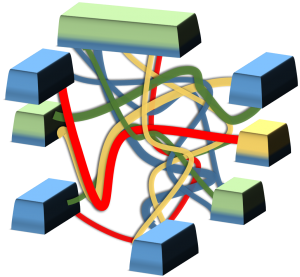Enterprise Architecture – Untangling the Business.
Blog: The Knowledge Economy
 Before engaging in business change, there is a need to understand where and how the business is situated. Executing change without this understanding can result in unintended and perhaps disastrous consequences.
Before engaging in business change, there is a need to understand where and how the business is situated. Executing change without this understanding can result in unintended and perhaps disastrous consequences.
When renovating an older property, It is rare that the original detailed plans and specifications are available to the project manager. This creates a potentially significant problem, with regards to the structural, plumbing and electrics and needs to be resolved prior to starting.
Attempting to excavate, remove walls or ceilings without knowing what lies beneath or inside, increases the risk of severing vital services necessary to the facility of the property. With knowledge of what is where, mitigating activities can be undertaken to avoid accidents. Rupturing a gas or water line, shorting an active electrical cable, disturbing asbestos or removing a load-bearing beam, could have serious consequences, lengthening time-frames, impacting structural integrity, dramatically increasing costs and placing safety at risk.
The competent building renovator, in order to effectively, efficiently and safely make the planned alterations, needs to undertake adequate investigations and preparatory work prior to commencing. Within a business context, it is likewise vital for the change-agent to make requisite enquiries and preparations. Applying change, without appreciating the consequences, is unproductive, potentially costly and may have disastrous ramifications for the whole business.
As in ‘the domino effect’, all change will impact at least some other part of the business. When modifying the function of a business system, it is imperative to understand the flow on effects. Asking questions before commencing, such as:
- What data is being changed?
- What other systems use this data?
- If this is changed will something else break?
- What else is affected by changing functionality?
- Will the current business processes continue to work?
- What else needs to be altered to support this change?
These answers are essential to provide insight into the impacts and tasks required in order to minimise any collateral damage. Similarities between the renovating analogy frequently occur within the business context, when the answers to these questions are not known and may require a significant investigation. Depending on the size and nature of the business, this vital enquiry may prove to be not only frustrating but also a lengthy and costly process.
Technology has long since supplanted most formerly paper-based data, yet storage and transfer of this information has often been haphazard. The consequence of rapid technological development means replacing both superseded software and hardware may often create issues of a chaotic approach to data content, context, storage and access. Ignoring or procrastinating resolving this problem only broadens the scale of ramifications as the business expands, weakening both its functionality and growth potential.
With a competent business infrastructure in place, the necessity and consequences of such complex investigations can be avoided. To better facilitate the change process, the advantages of an established Enterprise Architecture and associated knowledge base can be exploited. Having available comprehension of:
- What is physically connected to what.
- What are the information flows.
- Why connections are configured as they are.
- Who uses which systems and processes and why.
The benefits of an established Knowledge Repository supported by functioning and utilised Enterprise Architecture considerably eases the change process, providing enhanced business opportunities for growth.
Like the successful renovator who understands the complexities of the structure in which they are working, the change-agent within a business enterprise will benefit from understanding how the business is structured and why.
Leave a Comment
You must be logged in to post a comment.







